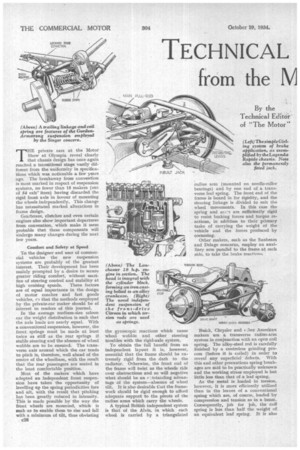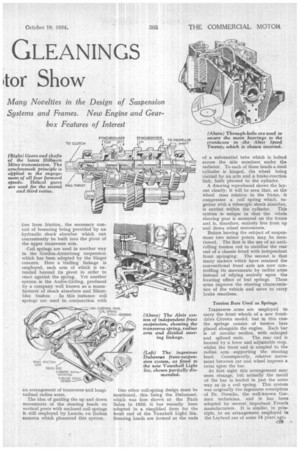TECHNICAL from the V GLEANINGS la Show
Page 50

Page 51

Page 52

If you've noticed an error in this article please click here to report it so we can fix it.
By the Technical Editor of "The Motor"
Many Novelties in the Design of Suspension Systems and Frames. New Engine and Gearbox Features of Interest THE private cars at the Motor Show at Olympia reveal clearly that chassis design has once again reached a transitional stage vastly different from the uniforreity in specificaflops which was noticeable a few years ago. The breakaway from convention is most marked in respect of suspension systems, no fewer than 15 makers (out of 54 eidf itors) having discarded the rigid front axle in favour of mounting the wheels independently. This change has necessitated marked alterations in frame design.
Gearboxes, clutches and even certain engines also show important departures from convention, which make it seem probable that these components will undergo many changes during the next few years.
Comfort and Safety at Speed To the designer and user of commercial vehicles the new suspension systems are probably of the greatest interest. Their development has been mainly prompted by a desire to secure greater riding comfort, without sacrifice of steering control and stability at high cruising speeds. These factors are of equal importance in the design of motor coaches and fast goods vehicles, re that the methods employed by the private-car maker should be of interest to readers of this journal.
In the average medium-size saloon car the weight distribution is such that the axle loads are nearly equal. With a conventional suspension, however, the front springs must be made at least twice as stiff as the rear springs if stable steering and the absence of wheel wobble are to be ensured. The transverse axis around which the car tends to pitch is, therefore, well ahead of the centre of the wheelbase, with the result that the rear passengers are seated in the least comfortable position.
Most of the makers which have adopted an independent front suspension have taken the opportunity of levelling up the spring periodicities fore and aft, with the result that pitching has been greatly reduced in intensity. This is made possible by the way the front wheels are mounted, which is such as to enable them to rise and fall with a minimum of tilt, thus obviating c2.8
the gyroscopic reactions which cause wheel wobble and other steering troubles with the rigid-axle system.
To obtain the full benefit from an independent layout it is, however, essential that the frame should be extremely rigid from the dash to the radiator. Otherwise, the front end of the frame will twist as the wheels ride over obstructions and so will negative what should be an e-Astanding advantage of the system—absence of wheel tilt. It is also desirable that the framework should be rigid enough to afford adequate support to the pivots of the radius arms which carry the nheels.
A typical British independent system is that of the Alvis, in which each wheel is carried by a triangulated
radius arm (mounted on needle-roller bearings) and by one end of a transverse leaf spring. The front end of the frame is boxed in for rigidity, and the steering linkage is divided to suit the wheel movements. In this case the spring and are-s are sufficiently rigid to resist braking forces and torque reactions, in addition to their primary tasks of carrying the weight of the vehicle and the forces produced by cornering.
Other makers, such as the Sunbeam and Delage concerns, employ an auxiliary arm parallel to the frame at each side, to take the brake reactions.
Buick, Chrysler and c1ier American makers use a transverse radius-arm system in conjunction with an open coil spring. The alloy-steel rod is carefully finished by a centreless grinding process (before it is coiled) in order to reveal any superficial defects. With this and other precautions spring breakages are said to be practically unknown and the working stress employed is but little less than that of a leaf spring.
As the metal is loaded in torsion, however, it is more efficiently utilized than in the leaves of a conventional spring which are, of course, loaded by compression and tension as in a beam. Consequently, job for job, the coil spring is less than half the weight of an equivalent leaf spring. It is also free from friction, the necessary control of bouncing being provided by an hydraulic shock absorber which can conveniently be built into the pivot of the upper transverse arm.
Coil springs are used in another way in the Gordon-Armstrong suspension which has been adopted by the Singer concern. Here a trailing linkage is employed, each arm of which is extended beyond its pivot in order to react against the spring. Yet another system is the Andre-Girling, produced by a company well known as a manufacturer of shock absorbers and Silent
bloc bushes. In this instance coil springs are used in conjunction with
an arrangement of transverse and longitudinal radius arms, The idea of guiding the up and down movements of the steering heads on vertical posts with enclosed coil springs is still employed by Lancia; an Italian concern which pioneered this system. One other coil-spring design must be mentioned, this being the Dubonnet, which was first shown at the Paris Salon in 1932; it has recently been adopted in a simplified form for the front end of the Vauxhall Light Six. Steering heads are formed at the ends of a substantial tube which is bolted across the side members under the radiator. To each of these heads a steel cylinder is hinged, the wheel being carried by an arm and a brake-reaction link, both pivoted to the cylinder.
A drawing reproduced shows the layout clearly; it will be seen that, as the wheel rises relative to the frame, it compresses a coil spring which: together with a telescopic shock absorber, is carried within the cylinder. This system is unique in that the whole steering gear is mounted on the frame and is, therefore, entirely free from up and down wheel movements.
Before leaving the subject of suspensions two minor points may be mentioned. The first is the use of an antirolling torsion rod to stabilize the rear end of a chassis fitted with independent front springing. The second is that many makers which have retained the conventional front axle are now controlling its movements by radius arms instead of relying entirely upon the locating effect of leaf springs. These arms improve the steering characteristics of the vehicle and serve to carry brake reactions.
Torsion Bars Used as Springs.
Transverse arms are employed to carry the front wheels of a new frontdrive Citroen model. but in this case the springs consist of torsion bars placed alongside the engine. Each bar is of circular section, with enlarged
and splined ends. The rear end is located by a lever and adjustable stop, whilst the front end is coupled to the radius arm supporting the steering head. Consequently, relative movement between car and wheel imposes a twist upon the bar.
At first sight this arrangement may seem strange, but actually the metal of the bar is loaded in just the same way as in a coil spring. This system was originally the ingenious conception of Dr. Porsche, the well-known German technician, and it has been adopted by several, important French manufacturers. It is similar, in principle, to an arrangement employed in the Leyland car of some 14 years ago. Even on chassis with conventional springing there is a general tendency to stiffen the frame. A cruciform bracing amidships is popular and many makers stiffen the side channels by auxiliary plates secured to the top and bottom flanges. In the new Larichesler chassis the stiffening member takes the form of a lattice, welded to the clannets.
The synchromesh gearbox is the most popular transmission unit this year, with the Wilson self-changing epicyclic system a close second. The only development of note in. respect of the synchromesh system is that it is now applied to three or even all four speeds, whereas formerly it was used for only two speeds.
Following the success of the Daimler • Co. with the Fluid Flywheel in combination with a self-changing box, .other makers are employing this box in conjunction with centrifugal clatehes of various types. These emulate in a mechanical manner the hydraulic action of the Daimler transmission. One of the most interesting is a new Talbot clutch in which a reversed free wheel ensures that the rear wheels can at all times drive the engine, whetho: or not the centrifugal mechanism is in operation. The use of a fluid flywheel by the Singer Co. in conjunction with a plate clutch and ordinary gea-box must also be mentioned.
• Planetary Overspeeel Gear.
some Private-car makers are realizing that the craze for top-gear performance has the disadvantage of necessitating a low axle ratio, which results in excessive engine revolutions when cruising. Consequently, they employ overspeeds of the kind familiar in commercial Vehicles. The Chrysler system represents .a departure in that the overspeed is. obtained through planetary gearing brought into actibri autornati-ally by centrifugal weights when 40 mph. is exceeded.
The Austin4fayes frictional drive may also be mentioned, as this gives an automatic overspeed for cruising and over-running. This ingenious transmission has now been on the market for 12 months and has reached a fully commercial stage of development.
In engines, the outstanding tendency 080 is to reduce all forms of noise,
mechanical and otherwise. Rubberinsulated engine mountings are universally used. Great care is taken over exhaust silencing and air silencers are generally fitted to the carburetter intake. Anoth r important point is the wide use of thermostats to control the starting mixture and the idling setting of the throttle.
Fully automatic ignition timing is also general, effected in many instances both by a centrifugal mechanism and by a suction diaphragm. This dual control, in accordance with speed and load, gives good results both in per fonnance and Tow fuel consumption. Supercharging is as yet represented only by a few sports cars, but it has made great technical progress.
In only a few engines, such as the Siddeley Special, Sunbeam, Wolseley and Citrobn, are cylinder liners employed. The general plan is to cast the crankcase and cylinder block in one piece, the bores being formed directly in the iron casting. Thermostatic control of 'water circulation is relied upon to give the quick " warming-up " necessary to reduce cylinder wear.
Certain sports-car makers employ a separate aluminium crankcase as giving a better chance for heat dissipation from the bearings. The Alvis design is of interest in that long main-bearing bolts are employed which pass right through the crankcase.
Non-detachable Cylinder Head, An important breakaway from convention is found in two new six-cylindered Lanchester engines, a detachable head having been discarded in favour of an integral design. The crankcase is of aluminium, and the cylinder block and head form a single iron casting bolted thereon. For small bores this system has the advantage of eliminating all gasket troubles; furthermore, the absence of holding-down bolts enables much more generous cooling spaces to bt provided. The valvas are mounted in the head and operated by push rods.
In conclusion, braking systems must be mentioned owing to the development of a new and interesting layout known as the Girling. Low frictional losses between the pedal and shoes are ensured by the utmost simplicity in the operating gear, and the whole system is in tension, thus obviating the springiness usually associated with rods in torsion. From a compensating link amidships (operated alternatively by the pedal or hand lever}, pull rods run fore and aft to distributing levers on the axles. From these levers rods are taken directly to the brakes, the shoes being expanded by a simple wedge mechanism.












































































































